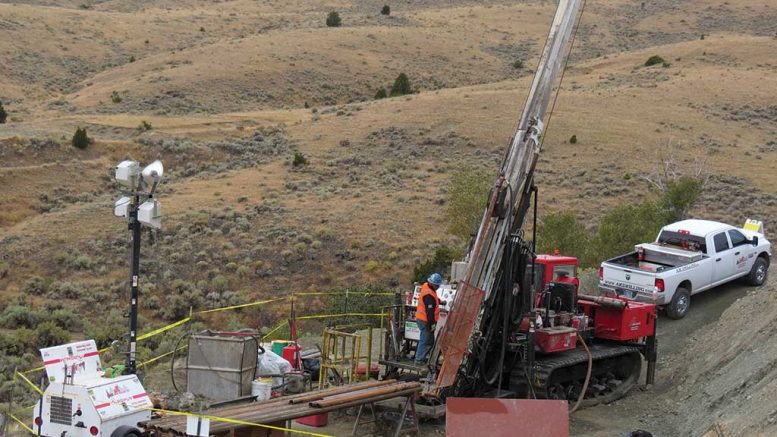VANCOUVER — Broadway Gold Mining (TSXV: BRD; US-OTC: BDWYF) is big-game hunting at its Madison gold-copper property in the historic Butte-Anaconda mining district, 38 km southeast of Butte, Montana.
The company picked up the 8 sq. km project package — which includes the dormant Broadway gold mine and contiguous Madison concessions — in late 2016. The site saw underground mining from the 1880s through 1950s, which yielded 408,000 tonnes of material at an grade of 9.1 grams gold per tonne.
In the mid-2000s, Coronado Resources spent US$10 million to trial mine at Broadway under “small miner exclusion” regulations.
Infrastructure at the site includes a crushing plant, certified weight scale and grid power. The mine development ran to 229 metres vertical depth and 610 metres laterally.

The underground development at Broadway ran to around 229 meters vertical depth, and over 610 meters laterally. Credit: Broadway Gold Mines.
“We’re taking a new, more systematic approach to the property. Previous operators had fast-tracked trial mining, but it seems like they fell victim to the commodity cycle,” Broadway Gold president and CEO Duane Parnham says during an interview. “The historical work has effectively solely focused around the known skarn-gold mineralization. Our team looked at the property and saw real potential within what is effectively a large-scale copper and gold porphyry district in the U.S.”
In initial drilling, Broadway confirmed the presence of native copper and copper oxide mineralization — plus some chalcocite (copper sulphide) — in areas west of the main underground workings. Next the company uncovered more copper-gold skarn mineralization, as well as a copper-bearing jasperoid zone.
Highlights from Broadway’s surface drilling to date include: 39 metres of 1.47% copper and 0.42 gram gold from 150 metres deep in hole 17-5; 49 metres of 1.73% copper from 177 metres deep in hole 17-16; and 20 metres of 1.47% copper and 0.25 gram gold from 118 metres in hole 17-13.

Surface drilling at the Madison property in January 2017. Credit: Broadway Gold Mining.
Meanwhile, underground drilling confirmed that copper-gold mineralization at Madison continues at depths below the 600 level.
Broadway Gold says it could consider extracting the high-grade gold values revealed to date using existing permits. Highlights from the subsurface drill campaign include 1.098% copper and 1.65 grams gold over 25.3 metres in hole 17-4.
“We did two phases of drilling and identified the new jasperoid and skarn zones with native copper and gold,” Parnham says. “In tandem with that program we did a property-wide, induced-polarization survey, which revealed a number of anomalous conductors, or chargeability anomalies, that pointed us away from the main adit. That helped us target what we thought might be a deeper-seated copper porphyry system.”
Broadway combined its geophysical and drilling work into a new geological model at Madison. The company now suspects that a porphyry system “produced a generation of fluids, which formed the skarn zones discovered to date along faulted-intrusive contacts currently exposed in accessible mine workings and at surface.”
On Oct. 26, Broadway identified what it calls a new latite porphyry zone of mineralization at Madison in hole 17-24. The company had drilled into an area of scattered historic prospect pits, within a section of carbonate rocks displaying skarn and jasperoid alteration, along what it calls a “well-mineralized, two-mile-long geophysical and geochemical trend.”

Broadway Gold president and CEO Duane Parnham. Credit: Broadway Gold Mining.
Broadway reports the intercept displays similar characteristics to latite-porphyry mineralization hosted 36 km away at Barrick Gold’s (TSX: ABX; NYSE: ABX) Sunlight operation in Whitehall, Montana.
“That core visually tells us we’re into the big system, which is highly altered and siliceous. So we’re seeing all the right signs,” Parnham says, noting his firm is awaiting assays and completing fluid-inclusion and source-alteration studies.
“We might be a bit high in the system right now, but I think it’s hard to argue we aren’t in a big, mineralized intrusive. It’s obviously the first hole here, but the follow-up drilling is already underway.”
Broadway reportedly hit the carbonate-latite porphyry contact at 300 metres down hole. The company said it cut a zone of phyllic alteration — from 309 metres to 321 metres down hole — consisting of closely spaced quartz-pyrite veinlets and pyrite microveinlets.
At writing, Broadway was 1,000 metres into a planned 3,000-metre drill program designed to test chargeability highs. Parnham says it should take up to three months to wrap up the campaign.

Hole 17-24 drill core illustrating the “carbonate-latite porphyry contact.” The company notes “chaotic folding and brecciation.” Credit: Broadway Gold Mining.
“We have enough cash left in treasury to do even more on the drill side following our third campaign, but absolutely there will be a lot more capital needed to fully understand the discovery,” Parnham says. “But that’s a good problem to have, and we’ll certainly be exploring strategic partnerships. I know senior mining companies love big porphyry deposits, and we know of a few larger companies poking around the area looking for copper.”
On Nov. 7, Broadway staked adjacent ground to Madison that covers the southern extension of a large chargeability anomaly and the Green Campbell fault zone, which defines a thrust fault between Archean basement rocks and skarn-jasperoid altered and mineralized Devonian and Mississippian carbonate rocks. The company’s wholly owned land package now exceeds 10 sq. km.
Broadway shares have traded in a 52-week range of 30¢ to $1.70 per share, and last closed at 35¢. The company has 36 million shares outstanding for a $13-million market capitalization, and has $2 million in its treasury.


Be the first to comment on "Broadway looks for porphyry discovery in Montana"